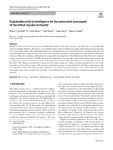Explainable artificial intelligence for the automated assessment of the retinal vascular tortuosity

Use este enlace para citar
http://hdl.handle.net/2183/36328Coleccións
- GI-VARPA - Artigos [79]
Metadatos
Mostrar o rexistro completo do ítemTítulo
Explainable artificial intelligence for the automated assessment of the retinal vascular tortuosityData
2024Cita bibliográfica
Hervella, Á.S., Ramos, L., Rouco, J. et al. Explainable artificial intelligence for the automated assessment of the retinal vascular tortuosity. Med Biol Eng Comput 62, 865–881 (2024). https://doi.org/10.1007/s11517-023-02978-w
Resumo
[Abstract]: Retinal vascular tortuosity is an excessive bending and twisting of the blood vessels in the retina that is associated with numerous health conditions. We propose a novel methodology for the automated assessment of the retinal vascular tortuosity from color fundus images. Our methodology takes into consideration several anatomical factors to weigh the importance of each individual blood vessel. First, we use deep neural networks to produce a robust extraction of the different anatomical structures. Then, the weighting coefficients that are required for the integration of the different anatomical factors are adjusted using evolutionary computation. Finally, the proposed methodology also provides visual representations that explain the contribution of each individual blood vessel to the predicted tortuosity, hence allowing us to understand the decisions of the model. We validate our proposal in a dataset of color fundus images providing a consensus ground truth as well as the annotations of five clinical experts. Our proposal outperforms previous automated methods and offers a performance that is comparable to that of the clinical experts. Therefore, our methodology demonstrates to be a viable alternative for the assessment of the retinal vascular tortuosity. This could facilitate the use of this biomarker in clinical practice and medical research.
Palabras chave
Blood vessels
Eye fundus
Ophthalmology
Deep learning
Genetic algorithms
Eye fundus
Ophthalmology
Deep learning
Genetic algorithms
Descrición
Financiado para publicación en acceso aberto: Universidade da Coruña/CISUG
Versión do editor
Dereitos
Atribución 3.0 España






